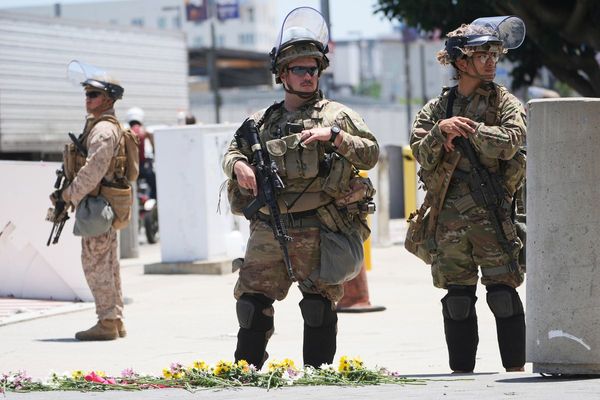A Chinese fighter jet deployed flares near an Australian surveillance aircraft over international waters in the South China Sea on Sunday, prompting Canberra to accuse Beijing of taking “unsafe” military action.
Defence minister Richard Marles said the Royal Australian Air Force (RAAF) P-8A Poseidon plane was on a routine surveillance mission when a People’s Liberation Army Air Force (PLA-AF) Su-35 approached.
“No damage was done but it was dangerous and it was unsafe, and inherent in that is that it could have been a different outcome,” he said, according to the Australian Broadcasting Corporation.
“This was an unsafe and unprofessional manoeuvre that posed a risk to the aircraft and its personnel,” a statement from the department of defence said.
“No injuries were sustained by Australian Defence Force (ADF) personnel nor was damage caused to the RAAF P-8A.
“The safety and wellbeing of our ADF personnel continues to be our utmost priority.”
Mr Marles said that the close release of flares during what was otherwise a routine exercise created an “unsafe” situation.
“As it (the RAAF plane) was doing that, a PLA Air Force [jet] came alongside – that, in and of itself is pretty routine,” he told Sky News.
“It released flares, that of itself can be a reasonably standard interaction between two military aircraft.
“But on two occasions, it released flares very close to the [the RAAF plane] and it’s really that, the proximity at which the flares were released, which has given us cause to deem this unsafe and unprofessional.”
He added: “Now to be very clear, all our crew are safe and obviously the plane landed without incident.”
Mr Marles emphasised the need for consistent conduct and communication in such situations, adding that any interactions deemed unsafe or unprofessional would be publicly disclosed.
“We do a lot of activity to assert the rules-based law around the South China Sea and, to be clear about it, it’s not gratuitous.
“Most of Australia’s trade goes through the South China Sea, and the rules-based order applying there is fundamental to our national interest.
Statement on unsafe and unprofessional interaction with PLAAF @DefenceAust
— Jennifer Parker (@JAParker29) October 20, 2025
‘On 19 Oct 2025, a RAAF P-8A Poseidon MPA conducting a maritime surveillance patrol in the SCS experienced an unsafe and unprofessional interaction with a PLA-AF Su-35 fighter aircraft’.
🔗… pic.twitter.com/bEcsdzIEus
“There are lots of interactions between our two defence forces and, by and large, those interactions happen in a manner which is safe and which is professional.
“But you know, there have been occasions where a lot of times they come close.
“There’s a lot of times where it’s both safe and professional but where it is unsafe and where it is unprofessional, we have seen those instances, we call it out and it’s important that we do that.”
The Australian government has formally communicated its concerns to Beijing, calling for all nations to operate military assets safely and professionally.
Australia’s defence ministry said in a statement: “For decades, the ADF (Australian Defence Force) has undertaken maritime surveillance activities in the region and does so in accordance with international law, exercising the right to freedom of navigation and overflight in international waters and airspace.
“All maritime claims must be consistent with the United Nations Convention on the Law of the Sea.”
This incident is the latest in a series of encounters between the ADF and the Chinese military, which has previously released flares and chaff near Australian aircraft and deployed sonar while Australian navy divers were in the water.
Analysts believe that China is seeking to push Australia and other Western nations out of the contested South China Sea and other maritime zones near its mainland.
China has expressed frustration over Australia’s joint operations and training exercises in the South China Sea with an expanding roster of partners, including the United Kingdom, the United States, Japan and the Philippines.
Australia has become the latest US treaty ally to accuse Beijing of failing to control its military operations in international airspace. In February, the two governments faced a similar clash in the South China Sea, when a Chinese J-16 intercepted an Australian P-8A patrol plane at close range.
At the time, China’s foreign ministry said its forces took “legitimate measures” to expel the foreign aircraft from claimed Chinese airspace.
Neither government revealed the exact location of the encounter.
Beijing claims sovereignty over much of the South China Sea, overlapping with the territorial claims of neighbouring countries. It has not yet issued a comment on the latest incident.
The Independent has reached out to the Chinese embassy in Canberra for comment.
John Swinney defends meeting with Chinese firm
King Charles and Cate Blanchett’s secret podcast interview released
Vietnam’s love affair with gas bikes is colliding with a new electric reality
Australians accused in fatal shooting of fellow national could face death penalty
Search ends for four-year-old boy missing in South Australia’s rugged outback
Australia shares tips on how to wean children off social media ahead of ban







